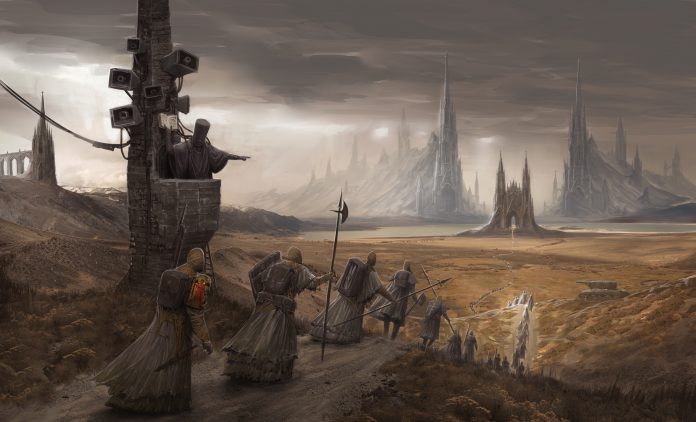At a glance, Trench Crusade is another ‘Weird War One’ style skirmish game; a new entrant into what is fast becoming a crowded field. But dig a little deeper and you’ll find gold. In short it’s a grimdark marriage between the bleak pointlessness of grinding trench warfare and a grand baroque vision of a millennia-long war between man and forces of Hell; a literal battle for man’s immortal soul. A game where trench clubs and gas masks meet Infernal Choristers, Stigmatic Nuns and the Lord of Tumours. In short, it’s camp as fuck.
Born from the mind of Mike Franchina, the world of Trench Crusade is horrific. In this alternate reality earth, the knight’s templar (those pesky bastards) commit the most horrific act in human history, opening the gates to Hell in Jerusalem and dooming the world to eternal war. Millions die in the centuries that follow as demons flood the earth and man struggles against the black legions of hell and their now corrupted followers. Whilst few bastions remain, barely holding the tide back, man still survives. Survives and thrives, beating back the foe with a strange blend of religion infused science; in Christendom with its Meta Christ Program and the Synod of Strategic Prophecy; to the walls of the Iron Sultanate with their great flesh works of the Jibrean Alchemists. Luckily by the time they reached 1914, the year in which the game is set, they also happened to have developed machine guns and gas grenades too.
The world of Trench Crusade originally began as an outlet for Mike to blow off steam after work. A concept artist by trade this output married a focus on intricate character design with thematic visual world building. From his work on Diablo at the time, there was a strong influence of the demonic, but also blending with other elements from horror, metal, historical arms and armour and ostentatious religiosity and, being a huge warhammer fan, some old school GW aesthetics. It eventually grew out of a personal art project when James Sheriff asked if he could sculpt six miniatures out of Mike’s designs, which they ran a kickstarter for in 2022. After smashing their goal and confirming that there is, in fact, a market for a demonic WW1 soldiery they started thinking about designing a game and reached out to their network from 28-mag. They eventually spoke to Tuomas Pirinen (of Mordheim fame) to see if he’d be interested. The result is Trench Crusade.
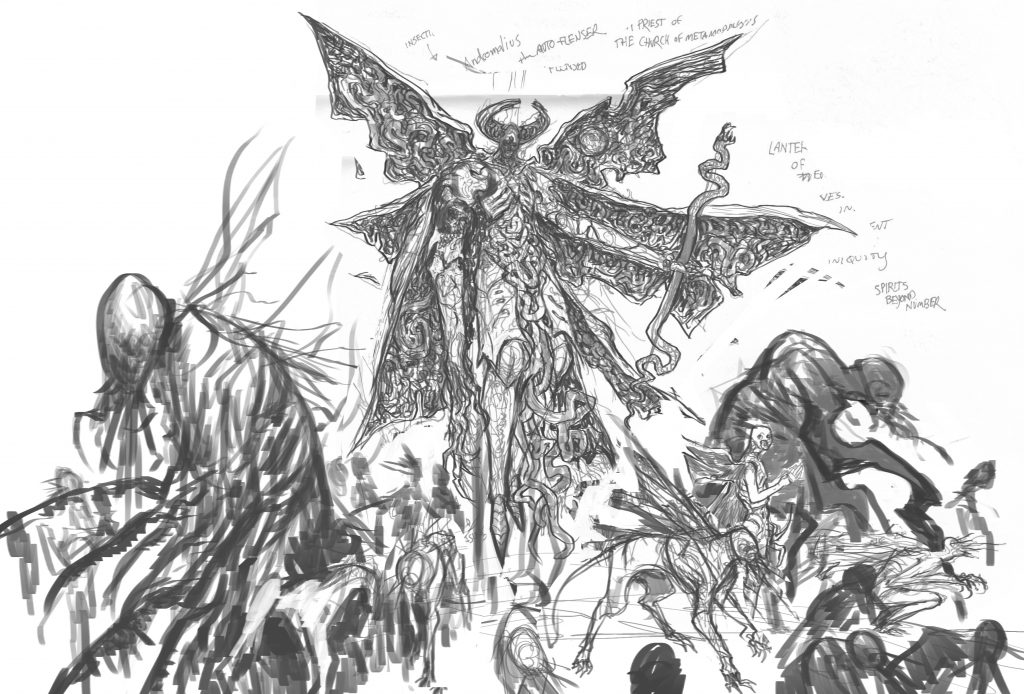
That’s a pretty compelling story but to honest if the Lore and Artwork haven’t 100% sold you on giving this a look, then it’s Game Design will. Designed by Tuomas Pirinen, this game mechanically feels very slick, with a crunchy core of a game of fighting bitter tense skirmishes in a blasted landscape, with layers of narrative rule writing woven through it, allowing your skirmish game to evolve into a compelling campaign. Like the best game design it captures the spirit of Franchina’s hellish images and realises them firmly within the rules themselves, with the pious Trench Pilgrims feeling like a bunch of fanatical zealots and the Court of the Seven Headed Serpent feeling absolutely demonic.
Pirinen’s design feels idiomatic of the game he’s best known for, Mordheim, so it’s hard not to make comparisons (If you want to read me gushing about that go read it here). But rather than being a rehash of that, Trench Crusade feels modern, reactive, whilst retaining the best bits of narrative led skirmish campaigns.
So how do you play it?
To play a game of Trench crusade, after picking your faction, you’ll first need to assemble a warband. This’ll consist of a requisite leader, some optional elite characters with special abilities, and various types of soldiers and other specialised units/beasts. If you’re playing in a campaign you’ll get 700 ducats to buy and equip your units, giving them weapons, armour and other specialised gear, or slightly more if you’re playing a one off game, but for the purposes of this we’re going to assume your playing a campaign, because that’s where the meat of this thing is.
All of your warriors will have the same sort of stats; a movement value, their modifier for shooting & melee (0, +dice or -dice), an armour modifier (if any), their equipment and their base size. Plus some sort of interesting special rules or an option to buy some.
After you and your opponent have assembled your forces and set up an appropriately grim looking 4×4 board you’ll pick one of a number of missions with different objectives, from holding ground in no-man’s land, destroying your opponents supplies, or raiding their earthworks. The player with the lowest number of models begins with the initiative and thus starts the game.
You’ll then take turns, activating one model at a time, with each performing as many single unique actions as you’d like them to; moving/charging, shooting, fighting and other special abilities. To resolve most actions you’ll be rolling 2d6, adding dice in to represent both positive (+DICE) and negative (-DICE) modifiers. Your roll determines your success with 6- as a fail, 7-11 as success and 12+ as a crit. If the action was ‘Risky’ (for example dashing after moving, using a dangerous weapon or one that requires careful aiming) and you fail that model’s activation ends and it’s over to your opponent.
As a core gameplay loop, this rocks. Alternating activations is perfect for skirmish combat, giving you a great reactive game space, meaning every activation is tactical and engaging. Coupled with this is an initiative system that favours the warband with fewer models, this helps prevent more elite warbands from being out-activated and enables some form of comeback mechanic if you’ve lost more models than your opponent. A 2d6 probability space is another big plus, giving you a nice bell curve of possibilities. Add to that positive and negative dice (if you’re rolling with positives you’re taking the highest possible roll, with negatives, the lowest) and you’ve got a really chewy little system.
When units are hit by weapons you’ll be rolling on an injury table, with models either fine, taking a minor wound, going down, or being taken out of action. Rather than possessing a wound stat, models accrue Blood Markers through these rolls; tokens on your models can be spent by your opponent to modify either future injury rolls (+DICE), increasing the chance to take them out of action, or debuff future actions (-DICE) decreasing their chances of completing actions.
This suddenly makes applying damage a lot more strategic, becoming a bit of a trade off; am I using those Blood Markers on the next injury roll to try to guarantee taking a model out, or do I instead use it now to debuff their next shooting action and reduce their threat on the table. It feels mechanically and narratively pretty satisfying, because of course being injured is going to reduce your effectiveness, scuppering your chances at a critical moment, and by giving your opponent the choice of when to use them it ups the tension in every activation.
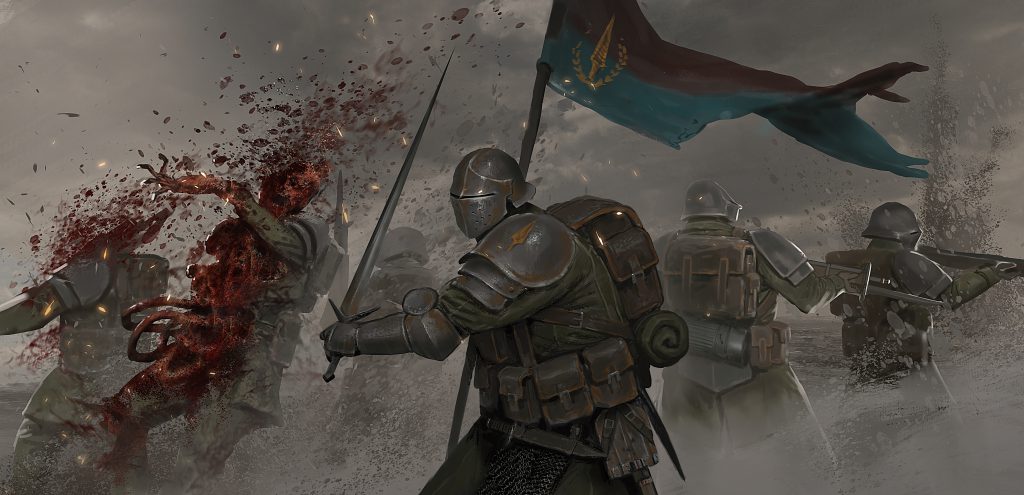
As you battle back and forth, models will go down and out of action, and if at the end of any of your turns, half of your models are incapacitated, you’ll have to take a morale test (a straight 2d6) to see if you stay in the fight. Otherwise you’ll be duking it out for around 6 turns (with some missions having tighter turn times). Once the game’s done you’ll tot up for VP for the mission objectives and declare a victor.
There are however some interesting secondary objectives that you can try and achieve with your force. These are called Glorious Deeds (hell yeah) and represent moments of desperate heroism/villainy, for instance: knocking an enemy off their sniper nest, taking out two enemies in a single combat or taking an enemy out with a model that’s down. Difficult but not unachievable, these can only be scored once per game and are the only way to secure Glory Points, a special secondary currency in the game. Glory represents the fame and acclaim your warband accrues over the course of a campaign. You can spend it on fancy gear for your force (like Submachine guns or Field Shrines) or to attract bizarre and arcane mercenaries to fight for you, like the Goetic Warlock or a Mendelist Ammo Monk.
After battle, you’ll enter a post-game phase where you’ll roll to see if any of your warriors that went out of action units become injured (or died). Any Elites that survive can gain new skills, gaining XP as they survive battles and complete Glorious Deeds, and there’s also a chance for any of your regular mooks to become Elites as well. You’ll then embark on the Exploration Phase, gaining a number of dice to explore the wasteland of Trench Crusade based on the veterancy of your warband, with warbands that have been in more fights rolling more dice and rolling on rarer tables. Whatever you roll you’ll get x10 the amount in ducats, with specific numbers meaning special locations with extra loot. Also if you get absolutely pummelled in a game, there’s an option to do a complete rebuy of your team at a higher level, forgoing the Exploration phase and emptying your treasury, but giving you a new complete roster.
Anyone who’s played Mordheim will be looking at this and thinking “This sounds familiar”. And you’d be right. It’s the best part of the game but with some extra refinements, smoothing out those ‘feels bad’ moments. Compared to Mordheim, because your heroes are uncoupled from your Exploration phase, you want to get them stuck in and scoring Glory Points which is exactly what you want them doing from both a mechanical and narrative perspective. It’s tight narrative game design.
I’m in! So Which Faction Should I Pick?
Good news for you is that they’re all rad, in their own uniquely horrific way. First you should probably pick a side; are you fighting for Man or the forces of hell. Whichever you pick you’ll have 3 delicious flavours to choose from. Not only, that but each faction also allows you pick a specific subfaction giving you spicy new gear and abilities (but we’ll save that for another article).
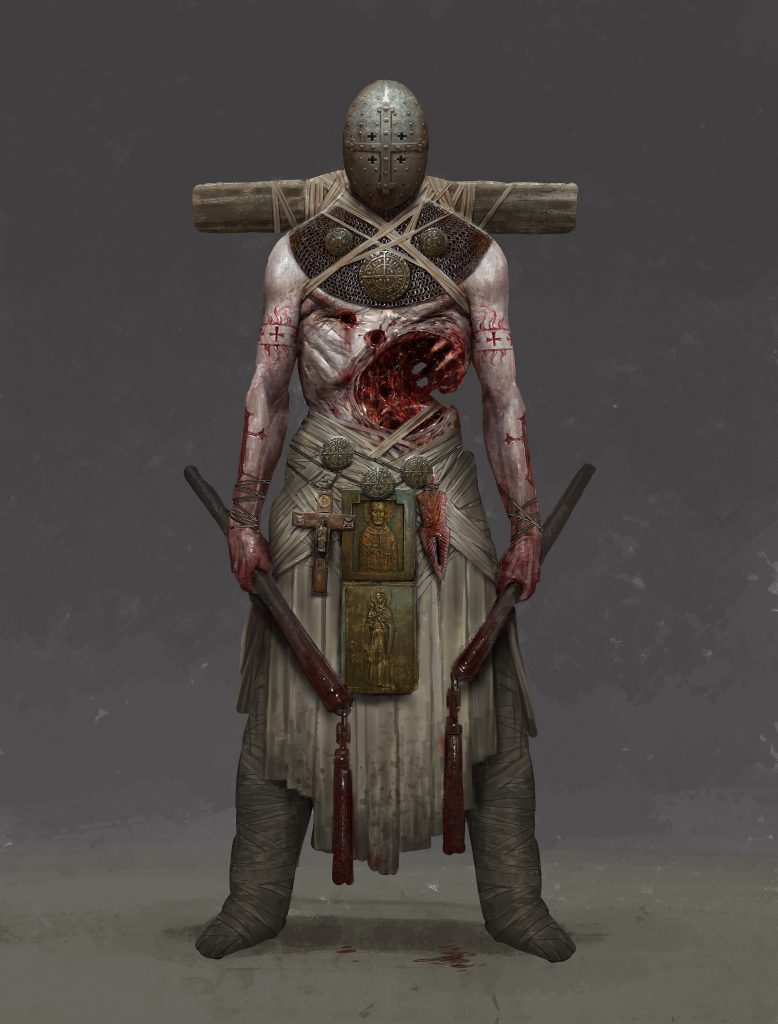
TRENCH PILGRIMS
Trench Pilgrims are the rag-tag procession of the mad, the guilty and the divinely inspired. Blessed (or haunted) by visions of His angels, these men and women congregate around Prophets who lead them into battle, hurling themselves at the heretic and the damned with righteous zeal.
How do they play?
They are mad zealots with guns and throwing crosses. They’re strong up close, with lots of abilities to get up the board and stay in the fight, like your War Prophets Loudspeakers which on a risky action can move anyone within 8” of the model, 3” up the board. What they lack in some of the more sophisticated gear of other factions, they more than make up for that with some really heavy hitters in the Communicant and the nigh unkillable Anchorite Shrine (basically a holy dreadnought).
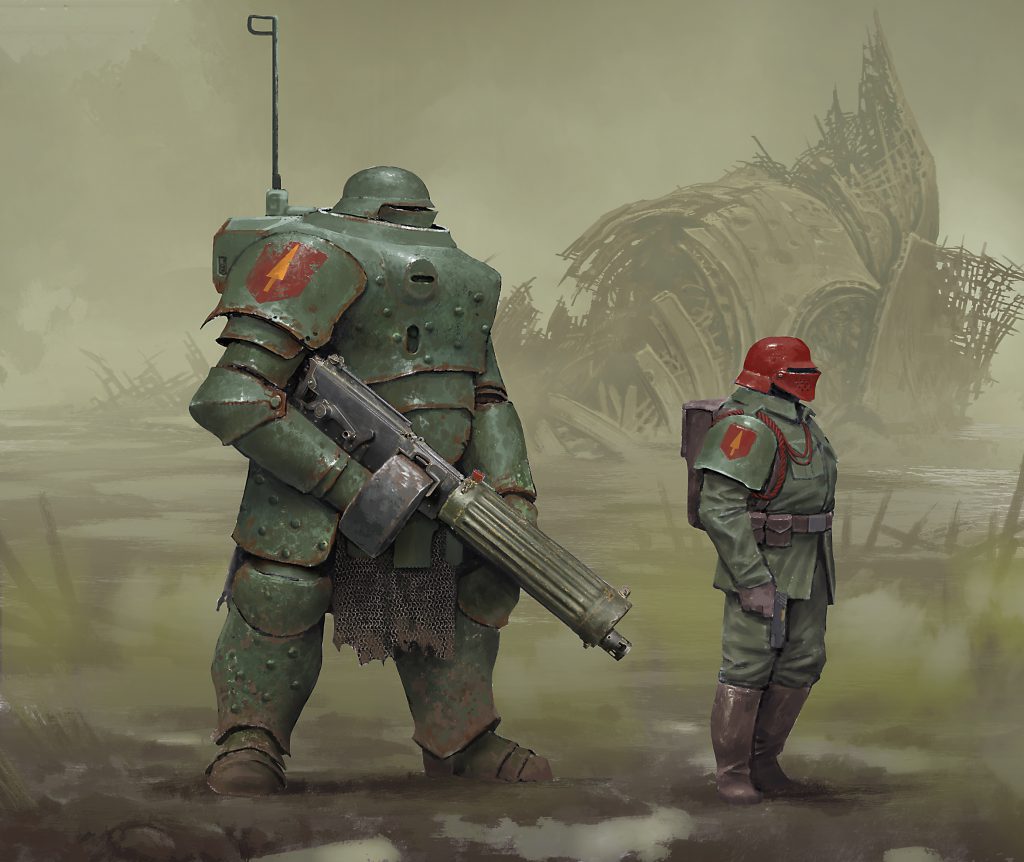
NEW ANTIOCH
The forces of New Antioch stand as the first line of defence against the forces of Hell. After being destroyed 300 years ago, the city has been rebuilt and acts as the focal point for the defence of Christendom, drawing men and women from its far reaches to fight at its bastions, beneath the very edge of the shadow cast by the gates of hell.
How do they play?
They play like a much more militarised force than other forces, focussing on firepower and shock assaults to win the fight. Their fireteams rule exemplifies this allowing two of your units to group activate together and when coupled with your Lieutenants ‘On My Command’ ability (that forces your opponent to activate one of their models) it can set you up for some very strong one-two punches. They’re one of the best equipped forces, with almost all mundane gear available to them for both ranged firefights and brutal combat, all culminating in their mechanised heavy armour, giving you the ability to run walking tanks on the battlefield.
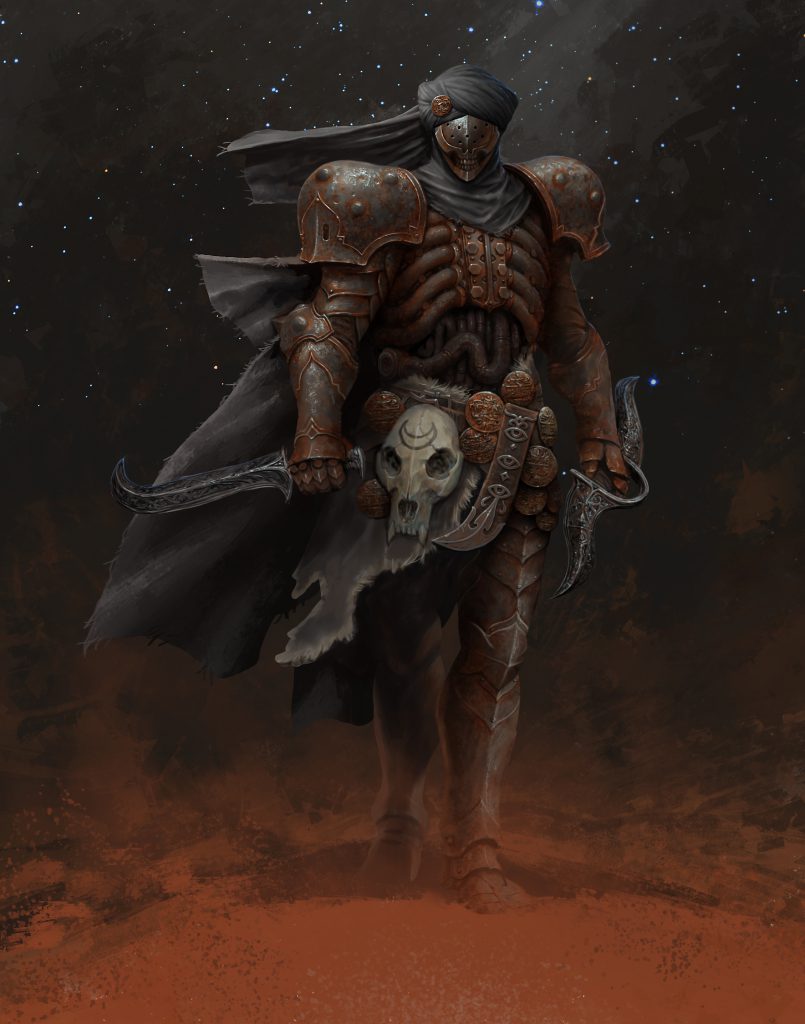
THE SULTANATE OF THE IRON WALL
The Invincible Iron Wall of Al-Quraysh protects the last true Sultanate and the faithful that reside within. Inside lost knowledge thrives, from the Assassins of Alamut who seem to bend space-time around themselves to the Alchemists of the House of Wisdom who blend technology and divine magic into their works, creating the ferocious Lions of Jabir and giant Brazen Bulls.
How do they play?
They’re a really versatile force to play with lots of interesting, flavourful units and specialist gear, from the time-slipping abilities of the Sultanate Assassin, allowing them to blink out of sight if your opponent misses a shot, or the flexibility of the Alchemists that can pick a keyword (Gas, Fire or Shrapnel) at the beginning of the battle depending on what your enemies weakest against. What they lack in mundane ranged firepower they more than make up for with vat grown flesh-beasts; from the Lions of Jabir, fast tough brawlers useful for flanking and hitting your enemy where it hurts, or the Brazen Bull, a huge monstrosity with a cannon for an arm that can smash straight through your enemies lines.
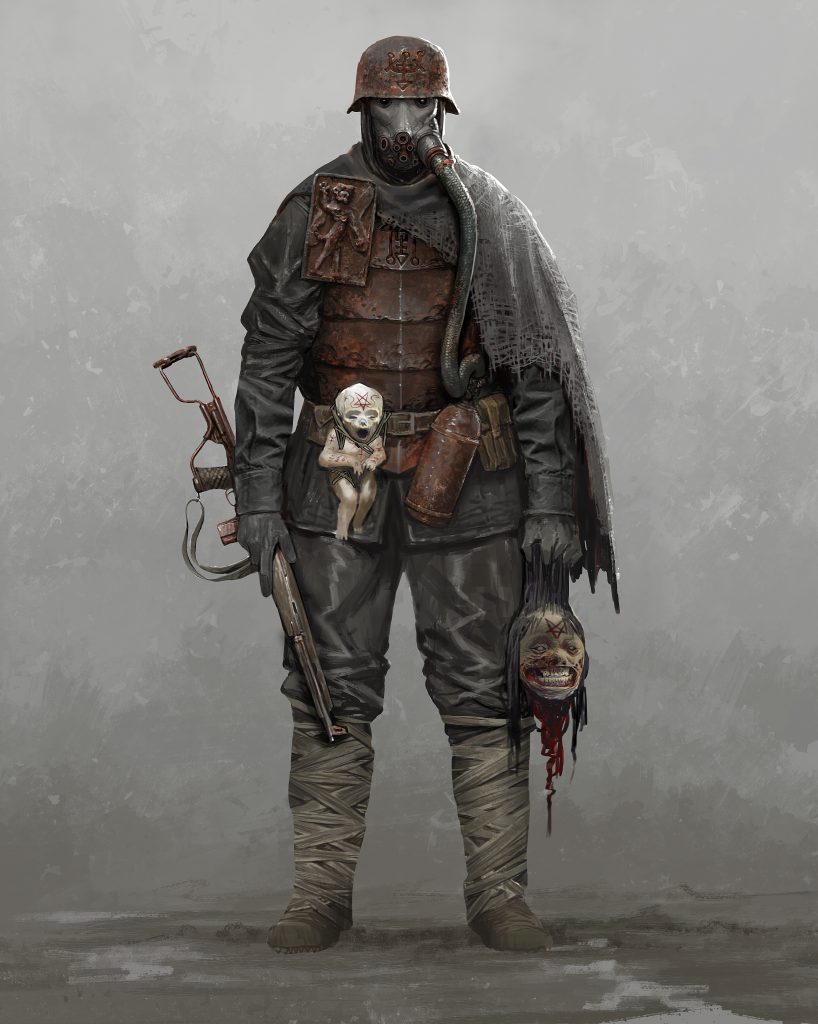
HERETIC LEGION
The heretic legions are the ‘human’ forces of hell. Or at least they once were. Living under the yolk of demons breeds only the most deranged and evil figures, twisted to serve only their demonic masters and their own sadistic passions.
How do they play?
If you want to play humans but evil, these are your guys. Their playstyle is very flexible with specialists both for long-range firefights and close quarters fighting. They’ve got some great gear and some really nasty abilities which can help give you the edge in any fight, like the horrific debuffing abilities of the Heretic Chorister or your Heretic Priests puppet master ability with which you can compel your enemies to throw themselves buildings or step directly into your firing lines. Their centrepiece units are the terrifying War Wolf, a tough vicious combatant who can rend most foes on the battlefield limb from limb or the Artillery Witch, who can summon infernal munitions to rain down upon your foes from across the battlefield.
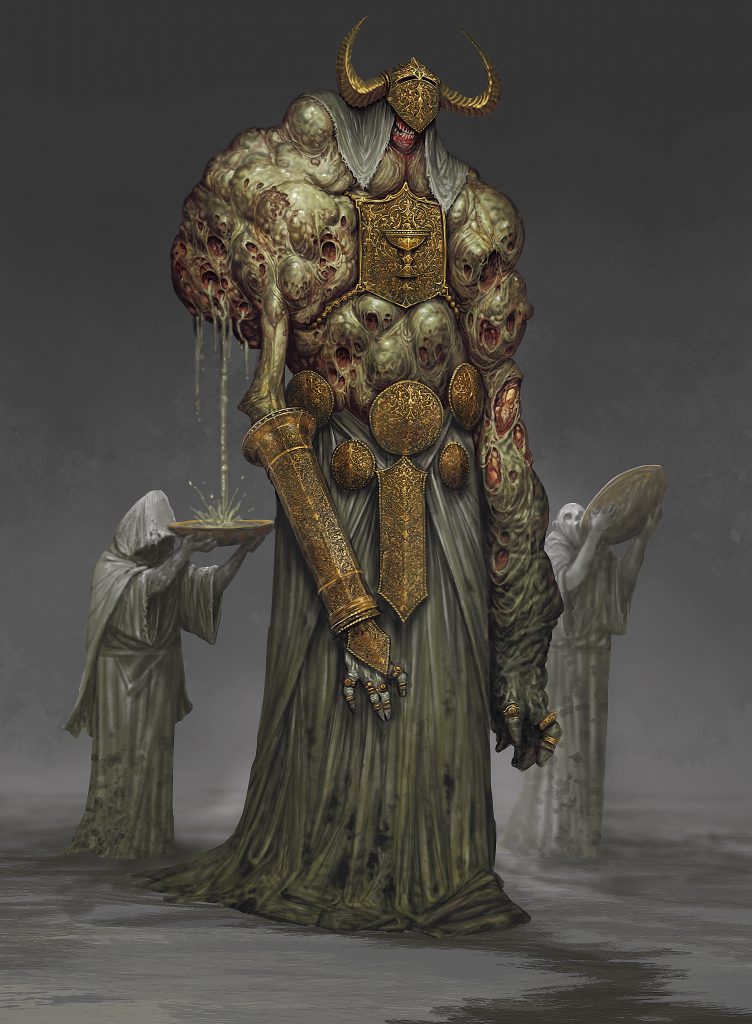
CULT OF THE BLACK GRAIL
Spawn of Beelzebub, the Black Grail infection hates all living things and seeks to turn all life into pestilent tumorous growth. As the infection spreads, it renders everything it touches into foul unlife, animating their corpses and driving them to mockingly gather in fervent bands under the watchful eye of Knights of the Order of the Fly, spreading the foul contagion to willing and unwilling alike.
How do they play?
This is your standard undead infection based army. They’re resilient and all cause fear, making them a lot harder to remove than most forces on the battlefield. A lot of their gear and special abilities play around with infection markers, a whole additional system for debuffing your enemy on top of regular blood markers, which helps guarantee that the fights you choose go your way. Despite being bloated corpses they’ve got fast movers, with Hounds and Heralds to flank your enemies and a corpulent big hitter in the form of the Amalgam, a twisted morass of corpses that can wield multiple weapons at once to great effect.
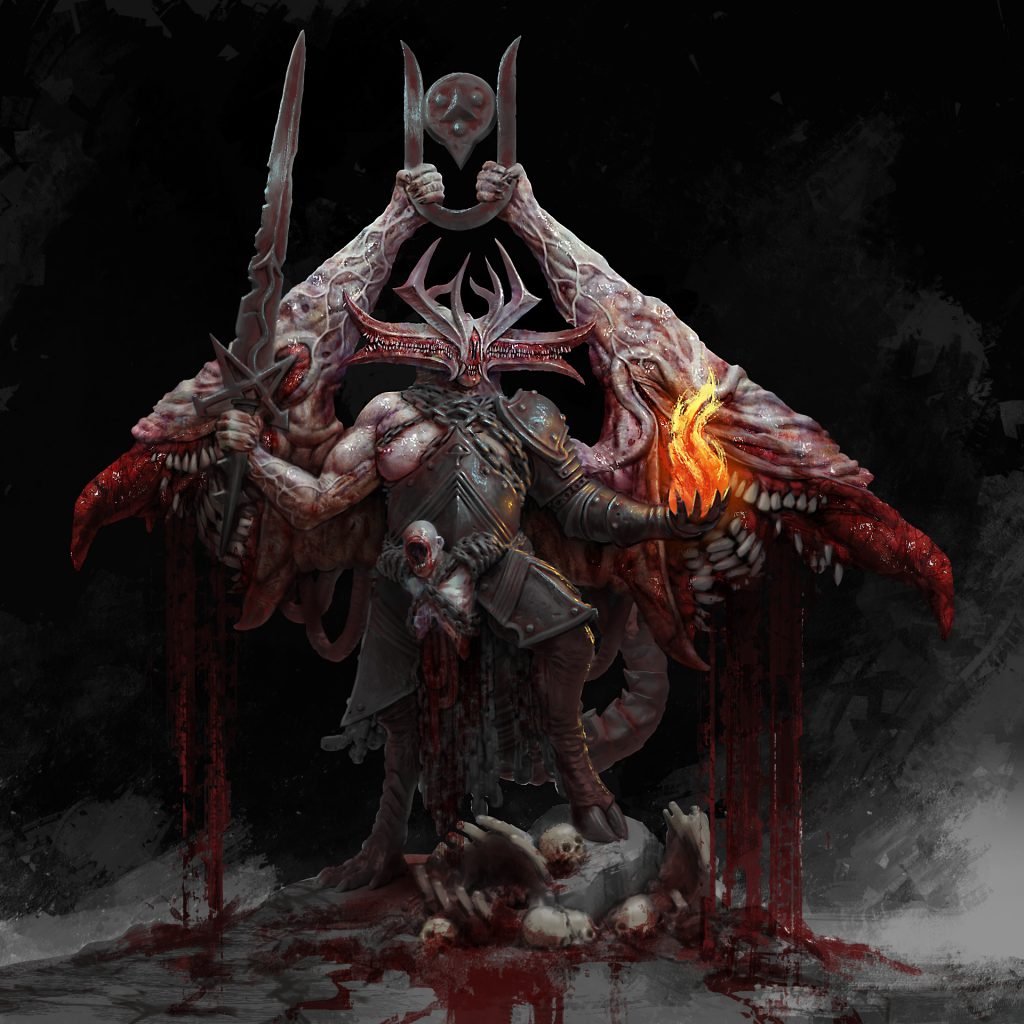
THE COURT OF THE SEVEN-HEADED SERPENT
The courts of hell are treacherous and ever-shifting internecine war. Each devil constantly vying to outdo one another to sit at the great council, where the seven Arch-Devils rule over all they survey. On their order warbands of fell beings are sent out into blasted landscape either to enact some great deed for their master, or just on a petty whim. When they walk, death is sure to follow..
How do they play?
Do you want to play horrific demons from hell? Then this is the warband for you. They’re an elite warband with very strong demonic units, that not only all cause fear, but also allow you to use twisted Goetic Magic, a system that lets you use any model’s (friend or foe) blood markers to cast your fell powers; their power is harnessed through suffering after all. These powers are mostly tied to the specific Sin your warband is built around. Once picked you can choose from several upgrades and Goetic powers to give you force; with Wrath allowing you to rush down the enemy, Lust to distract them or Sloth to sink them into idleness. And if that’s not enough for you, you can dispatch a Desecrated Saint, a multi-limbed melee horror, to annihilate your foes.
But how can I play if it’s not out yet?
Au contraire! Whilst this game is still technically in playtesting, beyond some small quirks it’s in a completely playable state. Go check out the main rules here and sign up to the Discord if you want to see the latest campaign rules.
And if you’re worried about models, whilst the Kickstarter sculpts look incredible, this is a model agnostic game. If you want to start playing this game sooner rather than later, then kitbashing some horrid soldiery is more than encouraged. A fantastic source of bits would be the Wargames Atlantic Great War range, with some great sprues that can be very easily blended with other plastic kits (though one note is that they are decidedly 28mm vs the 32mm scale that the game looks to be aiming for).
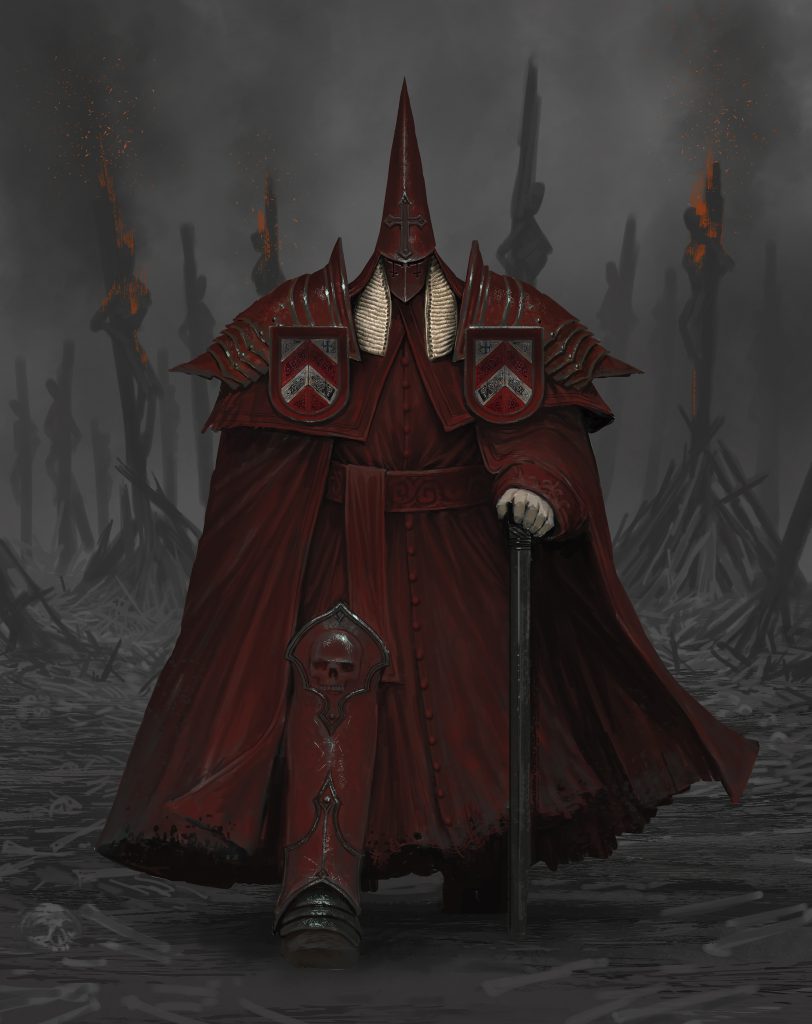
I heard this game was problematic? Is it?
Personally whilst I don’t think there are any historical periods that are Sacred Cows (brazen or otherwise) that can’t be remixed and used as the starting point for settings, WW1 is tough sell. For me, the significance of WW1 as an era that stands out from other globe bestriding imperial wars, was the sheer visceral pointlessness of it. What makes it an evocative setting beyond the imagery is that the leaders fighting this war did so using the outdated politics of Empire, where people became grist for the new machine of modern war in such egregiously obvious ways. It’s a real life satire of the failings of nationalism and 20th jingoistic politics. Making one side literally hell flattens that nuance out. WW1 becomes an aesthetic. I don’t think there’s necessarily anything wrong with that (gas masks look rad), but once you divorce yourself from the political reality of the era you leave yourself open people misunderstanding the vibe of what you’re trying to make.
And that’s unfortunately what happened. It turns out that when you make a game about aesthetically grimdark Christians battling the forces of hell, you will unfortunately attract a ‘very online’ section of the web; from ‘Deus Vult’ style Christian supremacists looking to LARP there own crusade against ‘deviance’ to Chuds with commissar avis that had given up trying to gatekeeper 40K and thought this was unwokehammer. Some of the worst™ people. This group clashed against the existing community in the 28 mag discord, where most of the playtesting for the game had been taking place. Wanting to avoid the Nazi bar parable, the team acted pretty quickly, freezing the 28mag discord and splitting Trench Crusade split off into its own little discord which before you’re allowed to start posting requires you to pledge an oath not to be weird (no homophobia, no racism, no xenophobia). It’s a pretty clear message and one that I hope holds up as the game goes into wider release.
Why you should play this game
The way I’ve tried to pitch this game to my friends who’ve been in the miniatures hobby for a while is that “it’s Mordheim but set in WW1 with demons”, but I think this is a little trite. Whilst it is similarly iterative on its grim dark aesthetic, its high level of customisability, narrative campaign design and implicit randomness, comparisons like these fundamentally tie Pirinen to a single game from 25 years ago that his design sensibilities have obviously evolved past.
But it’s hard not to draw comparisons because they’re all good. Alternating activations rocks for skirmish games. A 2d6 probability space with positive and negative dice feels really engaging to play with. All the weapon options and gear feel viable and pretty balanced. A lot of time narrative can be shorthand for flabby or asymmetrical rule writing but here it’s not. The game feels limber, balanced, but still very immersive. And coupled with an incredibly design aesthetic it’s hard not to sing its praises.
If you like the sound of this, you should absolutely check it out. Currently there’s a Kickstarter running until Tuesday 12th November, with the obvious cautionary note about over-commiting because of hype. I think this game’s amazing, but it won’t be everyone’s cup of tea, so do your due diligence and check your pile of shame/potential. This is a model agnostic game afterall. You might even be able to play the game already with what you’ve got. And you should play it. It rocks.
Have any questions or feedback? Drop us a note in the comments below or email us at contact@goonhammer.com. Want articles like this linked in your inbox every Monday morning? Sign up for our newsletter. And don’t forget that you can support us on Patreon for backer rewards like early video content, Administratum access, an ad-free experience on our website and more.
